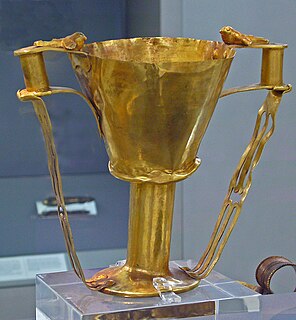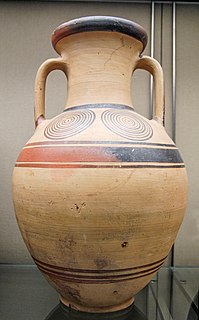 W
WThe Analatos Painter was an Attic vase painter of the Early Proto-Attic style.
 W
WThe Dipylon Amphora is a large Ancient Greek painted vase, made around 750 BC, and now in the National Archaeological Museum, Athens. Painted amphorae of this size were made as grave markers. The intact clay pottery vessel was found at the Dipylon cemetery, near the Dipylon Gate, in Kerameikos, the ancient potters' quarter on the northwest side of the ancient city of Athens. It is one of around 50 examples attributed to an unknown artist given the notname of "the Dipylon Master", one of the earliest individually identifiable Greek artists.
 W
WThe Elgin Amphora is a large Ancient Greek neck-handled amphora made from fired clay in Athens around 760 to 750 BC. The ceramic vessel may have been used to hold wine at a funeral feast, and then entombed with the cremated remains of the deceased. Fragments have survived, decorated in the Late Geometric style, and attributed to an unknown artist given the Notname of "the Dipylon Master", one of the earliest individually identifiable Greek artists. The fragments have been restored to reconstruct a single but incomplete vessel, 67 centimetres (26 in) high, which is now displayed at the British Museum in London.
 W
WThe Cup of Nestor or dove cup is a gold goblet discovered in 1876 by Heinrich Schliemann in Shaft IV of Grave Circle A, Mycenae. The cup has two handles, each decorated with a golden bird, which Schliemann observed was reminiscent of the cup of Nestor described in the Iliad. The birds have since been identified by Spiros Marinatos as falcons, rather than the doves which are on the Iliadic cup. J.T. Hooker suggests that the cup is an adaptation of a Cretan design made by a craftsman on the Greek mainland.
 W
WIn the Archaic phase of ancient Greek art, the Orientalizing period or Orientalizing revolution is the cultural and art historical period that began during the later part of the 8th century BC, when there was a heavy influence from the more advanced art of the Eastern Mediterranean and Ancient Near East. The main sources were Syria and Assyria, and to a lesser extent also Phoenicia and Egypt.
 W
WAncient Greek pottery, due to its relative durability, comprises a large part of the archaeological record of ancient Greece, and since there is so much of it, it has exerted a disproportionately large influence on our understanding of Greek society. The shards of pots discarded or buried in the 1st millennium BC are still the best guide available to understand the customary life and mind of the ancient Greeks. There were several vessels produced locally for everyday and kitchen use, yet finer pottery from regions such as Attica was imported by other civilizations throughout the Mediterranean, such as the Etruscans in Italy. There were various specific regional varieties, such as the South Italian ancient Greek pottery.
 W
WThe Protogeometric style is a style of Ancient Greek pottery led by Athens produced between roughly 1030 and 900 BCE, in the first period of the Greek Dark Ages. After the collapse of the Mycenaean-Minoan Palace culture and the ensuing Greek Dark Ages, the Protogeometric style emerged around the mid 11th century BCE as the first expression of a reviving civilization. Following on from the development of a faster potter's wheel, vases of this period are markedly more technically accomplished than earlier Dark Age examples. The decoration of these pots is restricted to purely abstract elements and very often includes broad horizontal bands about the neck and belly and concentric circles applied with compass and multiple brush. Many other simple motifs can be found, but unlike many pieces in the following Geometric style, typically much of the surface is left plain.